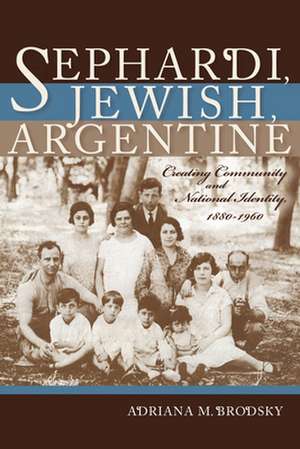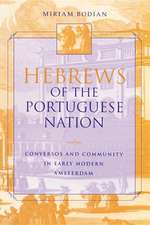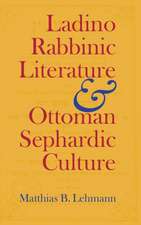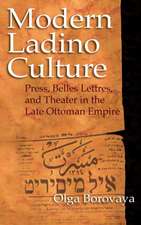Sephardi, Jewish, Argentine – Community and National Identity, 1880–1960: Sephardi and Mizrahi Studies
Autor Adriana M. Brodskyen Limba Engleză Paperback – 30 oct 2016
| Toate formatele și edițiile | Preț | Express |
|---|---|---|
| Paperback (1) | 194.41 lei 6-8 săpt. | |
| MH – Indiana University Press – 30 oct 2016 | 194.41 lei 6-8 săpt. | |
| Hardback (1) | 503.30 lei 6-8 săpt. | |
| Indiana University Press – 20 noi 2016 | 503.30 lei 6-8 săpt. |
Preț: 194.41 lei
Nou
Puncte Express: 292
Preț estimativ în valută:
37.21€ • 38.70$ • 30.71£
37.21€ • 38.70$ • 30.71£
Carte tipărită la comandă
Livrare economică 14-28 aprilie
Preluare comenzi: 021 569.72.76
Specificații
ISBN-13: 9780253023032
ISBN-10: 0253023033
Pagini: 286
Dimensiuni: 188 x 229 x 16 mm
Greutate: 0.41 kg
Editura: MH – Indiana University Press
Seria Sephardi and Mizrahi Studies
ISBN-10: 0253023033
Pagini: 286
Dimensiuni: 188 x 229 x 16 mm
Greutate: 0.41 kg
Editura: MH – Indiana University Press
Seria Sephardi and Mizrahi Studies
Notă biografică
Cuprins
Note about Translation and Transliteration
Acknowledgements
Introduction
1. Burying the Dead: Cemeteries, Walls and Jewish Identity in Early-Twentieth-Century Argentina
2. Helping the Living: Philanthropy and the Boundaries of Sephardi Communities in Argentina
3. The Limits of Community: Unsuccessful Attempts at Creating Single Sephardi Organizations
4. Working for the Homeland: Zionism and the Creation of an "Argentine" Sephardi Community after 1920
5. Becoming Argentine, Becoming Jewish, Becoming and Remaining Sephardi: Jewish Women and Identity in Twentieth-Century Argentina
6. Marriages and Schools: Living within Multiple Borders
Postscript
Notes
Bibliography
Index
Acknowledgements
Introduction
1. Burying the Dead: Cemeteries, Walls and Jewish Identity in Early-Twentieth-Century Argentina
2. Helping the Living: Philanthropy and the Boundaries of Sephardi Communities in Argentina
3. The Limits of Community: Unsuccessful Attempts at Creating Single Sephardi Organizations
4. Working for the Homeland: Zionism and the Creation of an "Argentine" Sephardi Community after 1920
5. Becoming Argentine, Becoming Jewish, Becoming and Remaining Sephardi: Jewish Women and Identity in Twentieth-Century Argentina
6. Marriages and Schools: Living within Multiple Borders
Postscript
Notes
Bibliography
Index





























